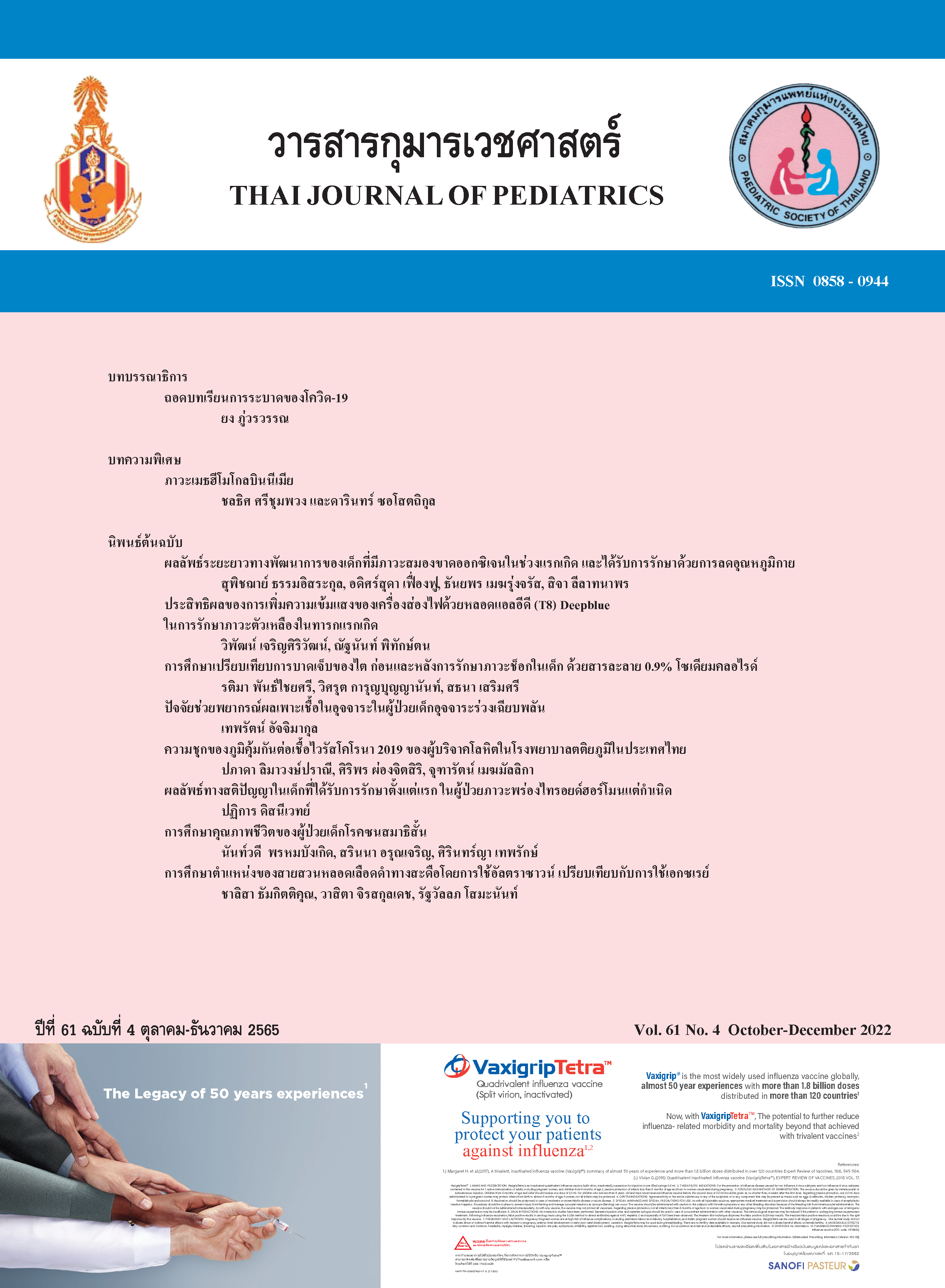ความชุกของภูมิคุ้มกันต่อเชื้อไวรัสโคโรนา 2019 ของผู้บริจาคโลหิตในโรงพยาบาลตติยภูมิในประเทศไทย
คำสำคัญ:
ความชุกของภูมิคุ้มกัน, ภูมิคุ้มกันต่อเชื้อไวรัสโคโรนา2019, โรคโควิด 19บทคัดย่อ
ความเป็นมา: ห้าเดือนหลังจากพบผู้ติดเชื้อไวรัสโคโรนา 2019 รายแรกในประเทศไทย ความชุกของการติดเชื้อไวรัสโคโรนา 2019 ถูกรายงานในระดับต่ำที่ 0.0043% โดยในเวลานั้นการตรวจหาเชื้อด้วยวิธี Reverse transcriptase polymerase chain reaction (RT-PCR) จะทำการตรวจวินิจฉัยเฉพาะในผู้ที่เข้าเกณฑ์การสอบสวนโรคติดเชื้อไวรัสโคโรนา 2019 ของประเทศไทยเท่านั้น
วัตถุประสงค์: เพื่อศึกษาความชุกของภูมิคุ้มกันต่อเชื้อไวรัสโคโรนา 2019 ในผู้บริจาคโลหิตซึ่งมีสุขภาพดี
วิธีการศึกษา: การศึกษานี้เป็นการศึกษาเชิงพรรณนาแบบตัดขวาง ทำการศึกษา ณ กองบริการโลหิตโรงพยาบาลภูมิพลอดุลยเดช ระหว่างเดือนกันยายน - ตุลาคม พ.ศ. 2563 ผู้เข้าร่วมการศึกษาคืผู้บริจาคโลหิตซึ่งมีสุขภาพดี อายุระหว่าง 17-70 ปี โลหิตที่เหลือจากส่วนที่แบ่งไว้สำหรับตรวจคัดกรองการติดเชื้อในการบริจาคโ]หิต ถูกนำมาทfสอบภูมิคุ้มกันต่อเชื้อไวรัสโคโรนา 2019 หากผลการทดสอบเป็นบวกจะมีการแจ้งผู้บริจาคโ]หิตกลับอย่างรวดเร็ว และให้มาโรงพยาบาลเพื่อตรวจหาการติดเชื้อไวรัสโคโรนา 2019 ด้วยวิธี RT-PCR ภายใน 7 วัน
ผลการศึกษา: ในช่วงเวลาระหว่างที่ทำการศึกษา ยังไม่มีวัคซีนโควิด 19 ถูกใช้ในประเทศไทย จากผลการศึกษาผู้บริจาคโลหิตทั้งหมด 1,550 คน พบผู้บริจาคโลหิตเพียง 2 คน มีผลภูมิคุ้มกันต่อเชื้อไวรัสโคโรนา 2019 เป็นบวก (0.13%, 95%CI: 0.04-0.47) และทั้งสองคนได้รับการตรวจหาเชื้อไวรัสโคโรนา 2019ด้วยวิธี RT-PCR ได้ผลเป็นลบ ทั้งสองคนปฏิเสธประวัติการติดโรคโควิด 19 มาก่อน ปฏิเสธประวัติการเดินทางจากประเทศซึ่งมีการระบาดของโรคโควิด 19 หรือสัมผัสผู้ติดเชื้อหรือสงสัปตเชื้อไวรัสโคโรนา 2019 ในสามเดือนก่อนหน้านี้
สรุป: ความชุกของภูมิคุ้มกันต่อเชื้อไวรัสโคโรนา 2019 ในผู้บริจาคโลหิตซึ่งมีสุขภาพดีในช่วงปี พ.ศ.2563 เท่ากับ 0.13% (95%CI: 0.04-0.47)
Downloads
เอกสารอ้างอิง
Cucinotta D, Vanelli M. WHO Declares COVID-19 a Pandemic. Acta Biomed 2020; 91: 157-60.
Tian S, Hu N, Lou J, et al. Characteristics of COVID-19 infection in Beijing. J Infect 2020; 80: 401-6.
Gao Z, Xu Y, Sun C, Wang X, et al. A systematic review of asymptomatic infections with COVID-19. J Microbiol Immunol Infect 2021; 54:12-6.
Bai Y, Yao L, Wei T, et al. Presumed Asymptomatic Carrier Transmission of COVID-19. JAMA 2020; 323: 1406-7.
Goudouris ES. Laboratory diagnosis of COVID-19. J Pediatr (Rio J) 2021; 97:7-12.
Gronvall G, Connell N, Kobokovich, A, West R, Warmbrod KL, Shearer MP, et al. Developing a National Strategy for Serology (Antibody Testing) in the United States. The Johns Hopkins Center for Health Security. April 22, 2020: https://www.centerforhealthsecurity.org/our-work/
publications/developing-a-national-strategyfor-serology-antibody-testing-in-the-US
Muench P, Jochum S, Wenderoth V, Ofenloch-Haehnle B, Hombach M, Strobl M, et al. Development and Validation of the Elecsys Anti-SARS-CoV-2 Immunoassay as a Highly Specific Tool for Determining PastExposure to SARS-CoV-2. J Clin Microbiol 2020; 58: e01694-20.
Whitcombe AL, McGregor R, Craigie A, et al. Comprehensive analysis of SARS-CoV-2 antibody dynamics in New Zealand. Clin Transl Immunology 2021; 10: e1261.
Bichara CDA, da Silva Graça Amoras E, Vaz GL, da Silva Torres MK, Queiroz MAF, do Amaral IPC, et al. Dynamics of anti-SARSCoV-2 IgG antibodies post-COVID-19 in a Brazilian Amazon population. BMC Infect Dis 2021; 21:443.
Department of disease control, Ministry of Public Health of Thailand. COVID-19 report in Thailand. DDC COVID-19 Interactive Dashboard [Internet]. [cited 2020 May 28]. Available from: https://ddc.moph.go.th/covid19-dashboard/?dashboard=province.
Valenti L, Bergna A, Pelusi S, et al. SARSCoV-2 seroprevalence trends in healthy blood donors during the COVID-19 outbreak in Milan. Blood Transfusion 2021; 19:181-9.
Amorim Filho L, Szwarcwald CL, Mateos SOG, et al. Seroprevalence of anti-SARSCoV-2 among blood donors in Rio de Janeiro, Brazil. Rev Saude Publica 2020; 54: 69.
Slot E, Hogema BM, Reusken CBEM, et al. Low SARS-CoV-2 seroprevalence in blood donors in the early COVID-19 epidemic in
the Netherlands. Nat Commun 2020; 11: 5744.
Erikstrup C, Hother CE, Pedersen OBV, et al. Estimation of SARS-CoV-2 Infection Fatality Rate by Real-time Antibody Screening of Blood Donors. Clin Infect Dis. 2021; 72: 249-53.
Fischer B, Knabbe C, Vollmer T. SARSCoV-2 IgG seroprevalence in blood donors located in three different federal states, Germany, March to June 2020. Euro Surveill. 2020;25:2001285.
National Blood Center, Thai Red Cross Society. Blood donor qualification [Internet].Blooddonation. [cited 2021Aug9]. Available
from: https://blooddonationthai.com/?page_id=745.
Department of disease control, Ministry of Public Health of Thailand. COVID-19 report in Thailand. DDC COVID-19 Interactive Dashboard [Internet]. [cited 2020 Oct 23]. Available from: https://ddc.moph.go.th/covid19-dashboard/?dashboard=province.
Coronavirus (COVID-19) Infection Survey, UK: 23 October 2020. [internet].2020[cited 2022 Jan 7]. Available from: https://www.
ons.gov.uk/peoplepopulationandcommunity/healthandsocialcare/conditionsanddiseases/bulletins/coronaviruscovid19infectionsurve
ypilot/23october2020.
ThaiPBS. 10 Countries with highest number of COVID-19 infections, as of April 25, 2020. Thai PBS World [internet]. 2020 [cited 2022 Jan 7]. Available from: https://www.thaipbsworld.com/10-countries-withhighest-number-of-covid-19-infections-asof-april-25-2020/
Steinhardt LC, Ige F, Iriemenam NC, et al. Cross-Reactivity of Two SARS-CoV-2 Serological Assays in a Setting Where Malaria Is Endemic. J Clin Microbiol 2021; 59: e0051421.
Galipeau Y, Greig M, Liu G, Driedger M, Langlois MA. Humoral Responses and Serological Assays in SARS-CoV-2 Infections. Front Immunol 2020; 11: 610688.
Randolph HE, Barreiro LB. Herd Immunity: Understanding COVID-19. Immunity 2020; 52:737-41.
ดาวน์โหลด
เผยแพร่แล้ว
รูปแบบการอ้างอิง
ฉบับ
ประเภทบทความ
สัญญาอนุญาต

อนุญาตภายใต้เงื่อนไข Creative Commons Attribution-NonCommercial-NoDerivatives 4.0 International License.



